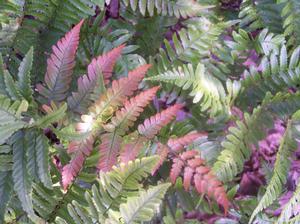View All Plants :: View All FERNS :: View All SHADE PERENNIALS
Dryopteris erythrosora 'Brilliance'
Autumn Fern
Plant Type:
FERNSDryopteris erythrosora 'Brilliance' – Copper orange new fronds mature to glossy green. It is its orange tone that is the reason for its common moniker, Autumn Fern. This spectacular fern is a presence in 3 full seasons through the winter solstice and is not knocked back until the harshest January weather takes its toll although in some years stems will break under the weight if ice-encrusted fronds if we have a nasty December ice storm. Morning sun to dappled shade in fertile, draining soil. USDA hardiness classification for Dryopteris erythrosora is confused to say the least; sources indicate hardiness in various combinations from zones 3 to 11. We don't actually know the northern or southern boundaries of growing compatibility but we suspect that the extremes as we have seen listed are verboten! In that, we are erring on the side of caution and suggesting zones 4 to 9 as probably legitimate. If anyone knows differently please contact us. Scroll down to the Genus Overview for more purple prose about ferns. Pot grown Division.
Characteristics and Attributes for Dryopteris erythrosora 'Brilliance'
Season of Interest (Foliage)
- Spring / Summer / Autumn
Nature Attraction
- Deer Resistant
Light
- Morning Sun / Afternoon Shade
- Dappled Shade
Attributes
- Massing
- Accent
- Border
- Specimen
- Cutting Garden
- Foundation
- Foliage
- Edging
- Natural Garden
- Ground Cover
- Woodland
Growth Rate in the Garden
- Medium
Soil
- Fertile
- Draining
Origins
- China
- Japan
Propagated By
- Division
Genus Overview: Ferns
Ferns. The easy, elegant and exceptional beauty of ferns cannot be understated. All ferns, beautiful as specimens unto themselves, are extraordinary in their simple ability to provide rich contrast to other companions wherever their requirements befit.
Habituated to so many environments many of the ferny pteridophytes – vascular plants that reproduce by spores, not seeds - are woodland denizens thriving on the cool, damp forest floor like the Christmas Fern, Polystichum acrostochoides with some preferring the wetter disposition of bogs, swamps, and stream banks such as Osmunda cinnamomea. Others will colonize gritty soils in shade or sun like the running Hay-scented fern, Dennstaedtia punctilobula and many among the Cheilanthes. Some are tough enough to grasp a foothold in the crack of a rock, these are lithophytic, as with Asplenium trichomanes. And some – most of these tropical in origin are truly epiphytic, clinging to tree bark as they unfurl their fronds from embryonic croziers to reach into the forest light such as the primitive looking Staghorn Fern, Platycerium bifurcatum or Rabbit-foot Fern, Davallia fejeensis .
And many have historic medicinal uses such as Maidenhair Fern, Adiantum pedtaum – this from medicinalherbinfor.org, “Expectorant, anti-rheumatic, demulcent, pectoral, refrigerant, tonic”... Native Americans throughout North America used maidenhair as a hair wash to make their hair shiny.” And in a more Bacchanalian use: as a flavoring in liquers.
There was probably something fern-like, an ancient ferny forebear(s) if you will, living during the Devonian some 60 to 70 million years ago. Ferns, some we still recognize today are descendents from an ancient order whose reign during the Carboniferous Age is legend, where giant horsetails and monstrous club mosses still populate the misty recesses of our dreams... and whose contemporary plundering by Homo sapiens in the vast burning of fossil fuels is altering our climate at such an alarming rate that more among the many are beginning to query as to the potential for another mass extinction – the closing chapter of another age, a blip in the larger context of perceived time. But I digress....
All our offerings are well-rooted pot grown divisions in 5 pint squares unless otherwise indicated. The quality we offer make them worth the money. We think you will agree.


